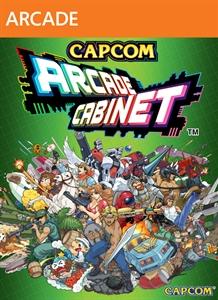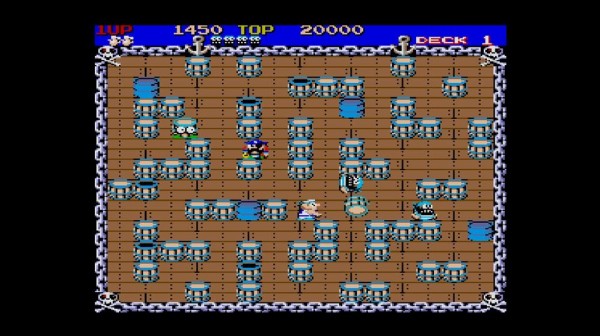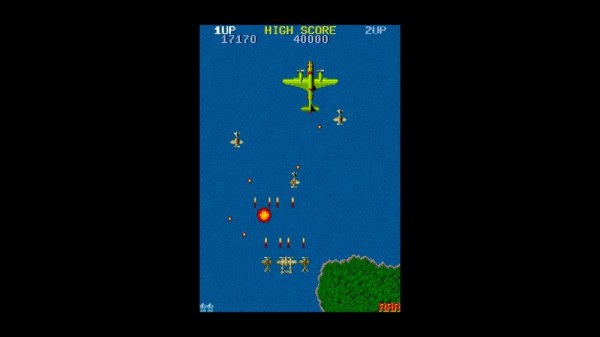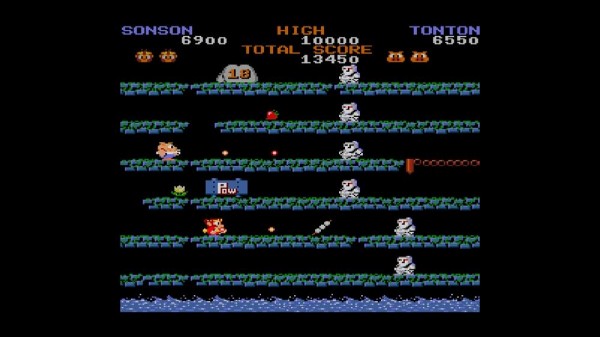
Capcom Arcade Cabinet 1984 Game Pack
Developer: Capcom
Publisher: Capcom
Platform: Xbox Live Arcade (Reviewed), Playstation Network
Release Date: April 16, 2013
Price: 800 Microsoft Points ($9.99 PSN) BUY NOW!
Overview
Say what you will about digital content, but when Capcom say they are going to deliver – they always pull through (fans of Mega Man, note the word digital content there). Capcom Arcade Cabinet has seen quite a bit of love over the past few months, capturing the publisher’s golden years in the arcade, but the releases are coming to a close, and what better way to cool off than in the year of 1984 with Pirate Ship Higemaru, 1942, and SonSon. Yes, we have gone back even further, where the gameplay is raw and the visuals even more simplistic. Was it wise for Capcom to go off with this collection on such a note, or is this finale satisfying enough to tie everything together? Let’s find out.
Gameplay
Pirate Ship Higemaru is the first title I decided to play out of this pack, as honestly – I had not even knew of it’s existence until viewing the game. Players take the role of a sailor by the name of Momotaro in this romp, and have to defeat a band of pirates Donkey Kong style. By that I mean barrels of course. You see, this title is set up like a maze and the enemies can kill with just a touch. It’s sort of like Pac Man, but without the dot collecting. Pirates that are lined up properly can be killed in succession, and once the player progresses to the next stage – the difficulty rises up and more pirates infiltrate the large ship of sorts. I really wish there were more to it, but this was 1984 and as it’s own product, Pirate Ship Higemaru doesn’t need a lot of gimmicks to be mindlessly entertaining.

Next up comes 1942, which of course came before the war plane themed shooter, 1943. All players need to do to win is simply fire away at every flying object that moves, collect power-ups, and avoid contact with enemies. Unlike 1943, this earlier version is much more unforgiving, as if you die – it is game over. There is no time to “insert another credit”, you just get to enter your initials, claim your high score – and try again. I’ll admit, I went in a bit cocky to the genre, but the score attack premise of all three titles here quickly grounded my mind, but the charm of a raw, authentic challenge was just too addictive to quit entirely. We see many titles that want to reward your failures with gold, and maybe that is a problem in today’s market. 1942 is all about teaching the player to dust themselves off and try again from the start. Sure, the gameplay isn’t as refined, but it does offer more reward than it’s successors, and that alone is what makes this aerial journey so enjoyable.

Finishing things up comes a game many have heard of, played, and love by the name of SonSon. Crafted more as a platformer than a shooter, players take control of our little ape friend and must scroll sideways, jump up and down to platforms, and shoot every enemy that crosses their path in order to progress. SonSon, out of all of the titles in this package is one I remember, but never fondly as the constant moving up and down while trying to shoot just seemed to be a little too overwhelming. That was when I was young however, and I have had more than enough time and experience these days to get the grasp of trial and error styled gameplay. The screen scrolling alone makes the player constantly stay on the edge, as there is no stopping to regroup after a swarm of enemies, it’s just one wave after another – and knowing when to jump up or down is crucial if you want to progress. I can say I still am not sold on SonSon being enjoyable due to my own taste palette, but after getting rather far this time around, I do have a bit of a new-found respect for the age-old classic.
Visuals and Audio
As I mentioned, these three titles are from the year 1984. Even compared to games that came out one year before, one will quickly learn about how fast technology moved due to the graphical limitations on display, as SonSon in particular features little animation and uses it’s gimmickry to make the game feel alive. Yeah, sure…these are all classics and that must be taken into consideration before dropping the gavel, but if you are someone looking for “Arcade Classics” that deliver in all areas, you probably won’t find it here as all that is present is the meaty, high-score themed gameplay mechanics with a side dish of cold, raw challenge.

The soundtracks present are really all about personal preference. 1942 in my opinion has the other two titles beat hands down in terms of music and sound effects, but many will probably take a liking to the other whimsical tunes offered up as they do fit well with their innocent protagonists. While not the most refined, I would say to take the audio as more of a history lesson from the year of 1984. This was the year where Atari had faded away and publishers were trying to shatter the market’s perception of video games – and with that in mind, it’s easy to see why these three titles started Capcom on a wave that continues to be rode by gamers looking for that special, raw experience that could never be replicated by anyone else.
Overall
1984 was a very transitional year in gaming. We live in a time now where the next crash of the industry looms due to DLC and DRM frustrations, as well as AAA titles never being able to sell enough. Back then however, that crash just occurred, and getting the gamer back into enjoying the hobby as a whole was the main goal, which was met through the deliverance of pure and challenging gameplay. Sure, these three titles will not blow anyone away, but serve this collection well as a turning point that took us out of the gutter and into the Super Mario Bros., Sonic, and Mega Man titles that truly revived the scene entirely. Due to that large factor, this trio belongs in every Capcom fan’s collection in one form or another, but if you have yet to add them to this digital Arcade Cabinet, there is no better time to make the download and rediscover the roots of one of the most loved companies in gaming history.

Capsule Computers review guidelines can be found here.

